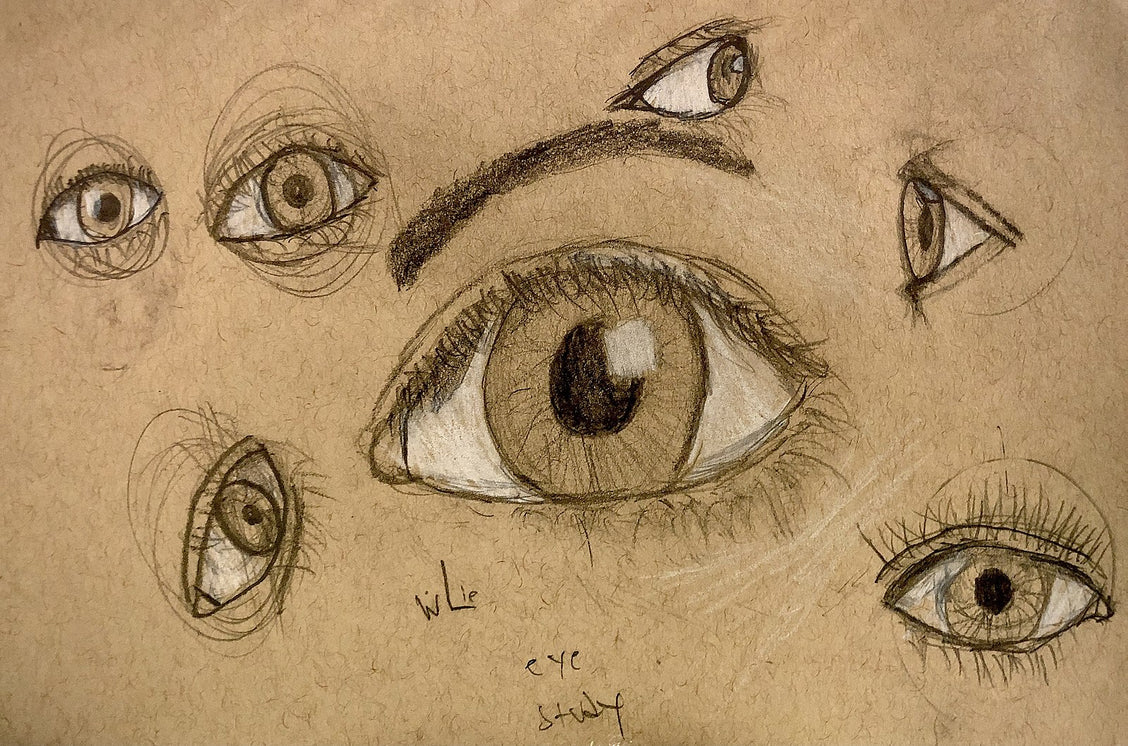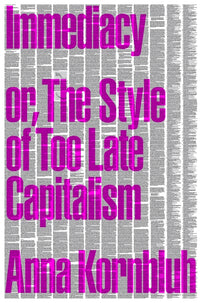Imaginary
Drowning in a deluge of images without context, words without meaning, information without distinction—this is the subjective experience in an economy of immediacy.

Immediacy stylizes the intensification of circulation, and nothing circulates faster than images. The human visual cortex processes stimuli at somewhere around sixty frames per second, with the ocular lens mirroring light into the retina, where photo-receptor cells convert it to electrical signals that the optic nerve ferries to the brain. Images viewed for as little as thirteen milliseconds can complete this information flow, called “feedforward processing,” and connect to concepts without any further feedback processes in the brain. The media ecology of the twenty-first century capitalizes upon this rapidity: user interface icons and integrated wearable devices obfuscate code; 5G data networks attain transfer speeds of ten gigabits per second; images online replace the fuller sensory experience of communicating, shopping, learning, or traveling in person; image-driven networks are the most popular media companies in the world and the most powerful, profitable data enterprises. There’s an app for that.
Google may be making us stupid, or Twitter may be making us mean—but, surely, the speed of the flow of information and the velocity of discretization are making our internal processors run on different stimuli. With algorithmicized consciousness, we click, we uptake. Seeing is reading. The superhighway acclimatizes perceptual faculties to racing, skimming, browsing, and other quick integrations. Immediacy style rapidly inputs information available on the surface as immanent unto itself, without need for slow, long reading or interpretation. And the internet as we know it has been built and regulated to ensure that this celerity of “surfing” concords with profit: as technology writer Nicholas Carr observes, “The faster we surf across the Web—the more links we click and pages we view—the more opportunities Amazon, Apple, and Alphabet gain to collect information about us and to feed us advertisements.” Platform capitalism entails the hyper-functioning of visuality as surrogate for other senses and precipitates the cognitive state of “image overload.” The frames per second the eye can handle are less than half what video cameras can relay; a torrent of images is wreaking serious symptoms researchers identify as memory impairment, heightened anxiety, generalized frustration, chronic fatigue, and simply “being overwhelmed by a constant flow.”
Drowning in a deluge of images without context, words without meaning, information without distinction—this is the subjective experience in an economy of immediacy. Whether or not technological advances in image circulation have a net democratizing effect (as many media scholars argue), and whether or not circulation can dispel the crisis of production, it is certain that they reconfigure cognition and affect. In the coming chapters of this book, we will mostly study how contemporary cultural aesthetics express circulation-intensification, seeking to understand the modulation of that base in art, literature, video, and theory that enthuse presence and immersion while negating mediation. This further prefatory chapter thickens the analysis by examining the everyday psychic contours that are both mainspring of and feedback to that style.
The psychic peculiarity of contemporary life, according to a certain trendy leitmotif, is an abundance of narcissism—“Generation Me” aggrandizement, measured definitively on the Narcissist Personality Index and Rosenberg Self-Esteem Scale. But, just as the most essential aspect of its pathology is false self-centering, our era of narcissism does not perceive its own structural causes. Nor does the narcissism hypothesis adequately comprehend the irrepressible crisis in mental experience at present. Ours is a miserable society (though the very palpability of this misery can prioritize psychological categories as somehow more primary or immediate than structural ones). For three years in a row and counting, the US has been the only developed country to experience a decline in average life expectancy, which the American Medical Association attributes to suicide, opioid addiction, alcoholism, and obesity, explicitly connecting these factors to wealth inequality. Group traumas like mass shootings and racist extrajudicial killing are escalating. Viral losses exacerbate all this distress: governmental abandon in the pandemic has made the US the world leader in excess death and suspended millions in protracted isolation. The teenage suicide rate increased 70 percent from 2006 to 2019, while overall suicide rates increased 2 percent per year over the same period. Significant majorities of young people in wealthy countries are repeatedly rated “extremely pessimistic about their economic futures.” Too-lateness also looms: according to the Pew Research Center, fully two-thirds of Americans say the federal government is doing too little to mitigate climate change, and one in five college students pursues treatment for climate grief. Recent studies estimate that over 40 percent of Americans are suffering from anxiety and depression. Anxiety is immersive, a case of apprehension involving breathlessness, dizziness, palpitations, an accumulation of undischargeable excitation. Depression, too, is immersive, an intrapsychic conflict of ego and superego that results in apathy, unwillingness to engage, and an inability to work through. Futurelessness, isolation, anxiety, distance: these plights trigger an overwhelming absorption, an incapacity to relate beyond the self in either language or action.
The category of immediacy connects both these immersive miseries and the apparent excess of ego to the technological transformations and economic contradictions we studied in “Circulation.” Immediacy’s stylized engrossments mimic our epidemic paths of suffering, its inundative presence swallows the horizon of no-future, its urgent extremities affright and awe, and its prized flow perpetuates the cult of “resilience” to which we are remaindered. Too late capitalism’s circulation-centricity expedites a historically contingent inflation of the image, and arguably, the subjective corollary is an inflation of the imaginary. An inner flood marked by a lack of symbolic constraint—an insufficiency of language (“no words”), a dearth of social ties, a reflective glass maze, overflowing oceanic feeling—casts the psychic style through which immediacy grips. Intensity intensifies.
This is an excerpt from Immediacy by Anna Kornbluh.
[book-strip index="1" style="buy"]
